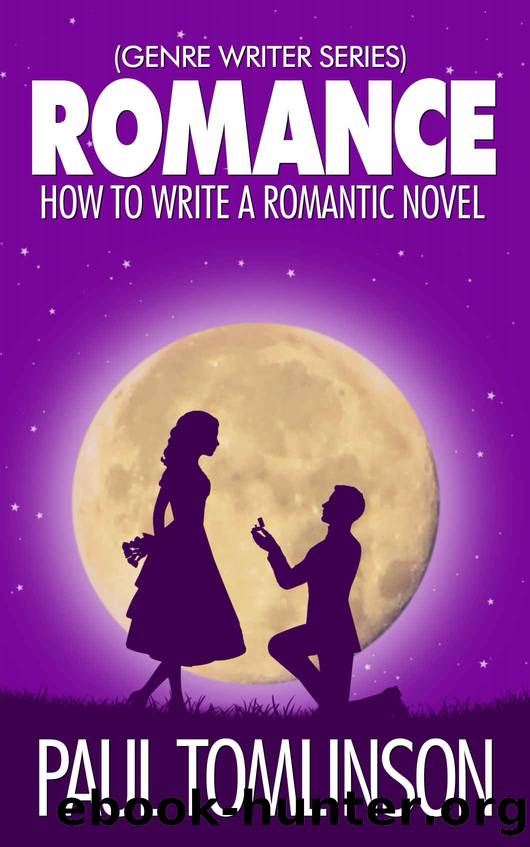Romance: How to Write a Romantic Novel by Paul Tomlinson

Author:Paul Tomlinson
Language: eng
Format: mobi, pdf, azw3, epub
Publisher: Paul Tomlinson
Published: 2022-12-10T22:00:00+00:00
A relationship saboteur has several techniques available to him (or her). The most obvious is disinformation â telling lies or manufacturing false evidence. This may take the form of spreading false rumours, perhaps in the form of an exaggeration of something that is partly true. Or it may involve planting evidence for a personâs lover to discover. A saboteur can deliberately cause any of the things mentioned in the misunderstanding section above to occur. They could plant the equivalent of lipstick on the collar or a hair of the wrong colour. They could fake love letters or other forms of communication. Or they could just do things that make the heroine or hero look bad in an attempt to get the other person to end the relationship.
A jealous best friend may deliberately seek to ruin the moment, doing something to sabotage the romantic date that their friend has carefully arranged for their lover. In a romantic comedy, you can have some fun showing the jealous best friend âstalkingâ the lovers and setting up some simple or elaborate form of moment killer. The best friend might amusingly fail to achieve his objective initially â perhaps two attempts have the opposite effect, making the relationship stronger â before he or she succeeds at the dark moment. You might even have the best friend realise that they are wrong to try and ruin their friendâs happiness and give up on the sabotage, only to wreck the relationship accidentally or through a delayed bit of sabotage.
If the saboteur functions as a mentor or confidante to the heroine or hero, they can provide bad advice. This poor advice will be deliberately designed to make the character look bad and ruin the chances of impressing their lover. Again, in a romantic comedy you can have fun by having the saboteur give obviously bad advice. They may base the advice on knowledge that the hero or heroine doesnât have â knowing something what will annoy, upset, hurt, offend, or otherwise disorientate the lover.
Itâs worth pointing out that some reasons for a break-up are more dramatic or emotional than others. If the behaviour of one character causes the other to break-up with them, you have a break-up based on legitimate conflict and the reader may sympathise with the wronged individual. If one character breaks up with another because of a mistaken belief, you add an extra element. The reader will know that the person who has just been dumped doesnât deserve it, and so their sympathy will be with the person who is the victim of the dumping. And finally, you have the character who doesnât want to end a relationship, but does so because they feel it is in the best interests of the person they love â in this case, the reader is likely to feel sympathy for both characters.
To end the chapter, we will consider a couple of potential pitfalls when creating your charactersâ break-up. The fact that the romance âformulaâ says that you must
Download
Romance: How to Write a Romantic Novel by Paul Tomlinson.pdf
Romance: How to Write a Romantic Novel by Paul Tomlinson.azw3
Romance: How to Write a Romantic Novel by Paul Tomlinson.epub
This site does not store any files on its server. We only index and link to content provided by other sites. Please contact the content providers to delete copyright contents if any and email us, we'll remove relevant links or contents immediately.
| Authorship | Bibliographies & Indexes |
| Book Industry |
Autoboyography by Christina Lauren(4703)
Asking the Right Questions: A Guide to Critical Thinking by M. Neil Browne & Stuart M. Keeley(4641)
Dialogue by Robert McKee(3635)
Eat That Frog! by Brian Tracy(3564)
Sticky Fingers by Joe Hagan(3474)
Journeys Out of the Body by Robert Monroe(3029)
Elements of Style 2017 by Richard De A'Morelli(2963)
Annapurna by Maurice Herzog(2874)
Schaum's Quick Guide to Writing Great Short Stories by Margaret Lucke(2829)
Full Circle by Michael Palin(2804)
The Diviners by Libba Bray(2468)
The Art of Dramatic Writing: Its Basis in the Creative Interpretation of Human Motives by Egri Lajos(2442)
The Mental Game of Writing: How to Overcome Obstacles, Stay Creative and Productive, and Free Your Mind for Success by James Scott Bell(2413)
Why I Write by George Orwell(2387)
Atlas Obscura by Joshua Foer(2371)
In Patagonia by Bruce Chatwin(2298)
The Fight by Norman Mailer(2180)
The Elements of Style by William Strunk and E. B. White(2090)
Venice by Jan Morris(2073)
